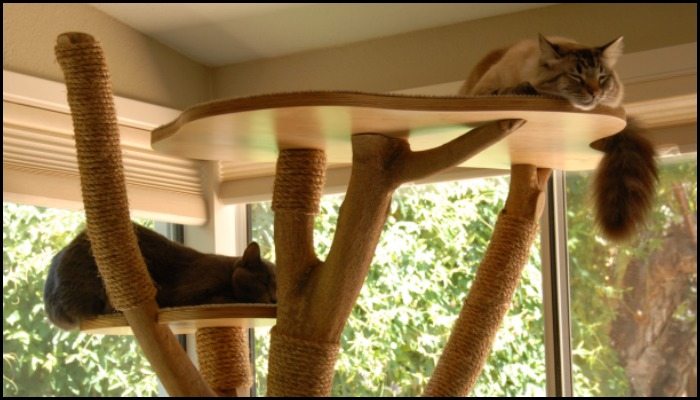
Got an old, small-sized tree in your yard that needs to be cut down? Instead of chopping it down into small pieces and getting rid of it, you can turn the entire tree into a classy cat tower! Any cat, yours included, would love this resting/playground area ;)
People mostly live in a horizontal world – but cats aren’t limited to the horizontal. They also love the vertical aspects of their environment. They rely on vertical objects for safety, comfort – and, yes, fun. All of those are crucial parts of feline life.

This project is one of the simpler cat towers you can build. The first step is to imagine and decide how your cat tree would look. Take into account the weight distribution or balance, so it doesn’t easily fall on anything and anyone!
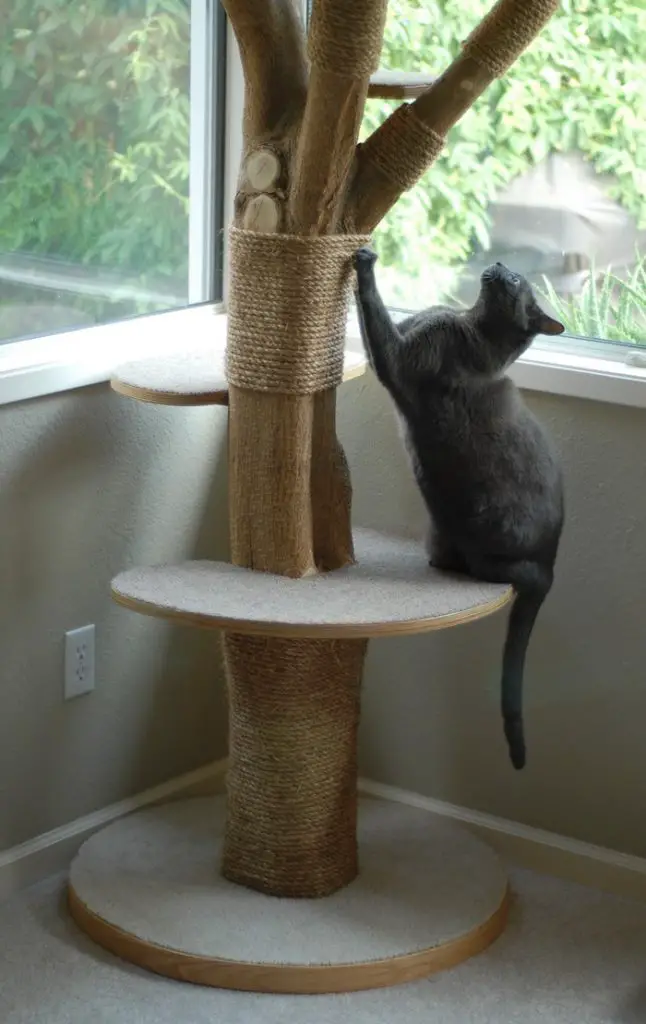
Contents
Turning an Old Tree Into a Cat Tower
Do you know any cat lovers out there who would love this idea? We’re sure your cat would! Check out how to turn an old tree into a cat tower here!
Materials
- Old Tree
- Plywood
- Oak Trim
- Manilla Rope
- Lag Screws
- Wood Screws
- Cardboard (for template)
- Wood Glue
- Finish Nails
- Carpet
- Oil-based Urethane
- Carpet Tape
- Greenhouse Staple
Tools
- Sabre Saw
- Cordless Drill
- Jigsaw
- Laser Level
- Cutter
- Belt Sander
- Router
- Spindle Sander
- Steam Cleaner
- Scissors
- Band Clamp
- Hammer
- Nail Gun
Instructions
Creating a cat tree from real tree branches not only provides a natural look but also ensures a sturdy and eco-friendly structure for your feline friends. Here’s how to combine the rustic charm of nature with practicality and comfort for your cat.
Step 1: Preparing the Tree
- Inspect and Select
- Find a fallen tree trunk or branch at least four inches in diameter. Ensure it is straight, dry, and free from pests. Confirm the tree species is non-toxic to cats.
- Trim and clean the tree
- Use a sabre saw to remove any unwanted branches. Clean the trunk and remaining branches with a steam cleaner to eliminate any dirt and pests.
- Sand the tree
- Use a belt sander to smooth the trunk and branches, eliminating rough spots and splinters.
Step 2: Attaching a Base to a Cat Tree Trunk
- Position the Plywood Base
- Begin by flipping your cat tree trunk so the bottom is exposed. Center a 24-inch square piece of plywood on the trunk’s base, ensuring it’s aligned with the middle of the trunk.
- Secure with Screws
- Using three 6-inch screws, attach the plywood to the trunk. Space the screws evenly around the center to ensure stability.
- Adjust Screw Depth
- For a seamless finish, remove each screw one at a time. Use a spade bit to drill a shallow hole at each screw location. This will recess the screw heads, so they don’t stick out.
- Reinstall the Screws
- Place the screws back into the pre-drilled holes, ensuring they fit snugly within the recesses.
- Check Stability
- Flip the trunk assembly upright to stand it on the newly attached base. Confirm the base is stable and doesn’t wobble. Adjust as needed to ensure the surface rests evenly on the floor.
Step 3: Designing the Structure
- Create a design template
- Sketch out the shapes of the platforms you want with cardboard. This will serve as a guide for cutting plywood.
- Cut the plywood
- Using a jigsaw, cut the plywood based on your templates to form the platforms.
- Sand the edges
- Smooth the edges of the plywood platforms with a spindle sander to prevent splinters.
- Prepare Slots
- Measure 16 inches from the trunk’s base and cut a slot ¾” wide and 2 inches deep for the bottom platform. Repeat for the middle platform 18 inches above the first.
Step 4: Assembling the Platforms
- Attach Oak Trim
- Shape oak trim with a router, attaching it around the plywood edges with wood glue and finish nails for a decorative touch.
- Drill and Secure
- Drill holes in the tree for platform attachment. Insert plywood into the slots and secure with lag screws.
- Carpet the Platforms
- Cut the carpet to fit each platform, securing it with carpet tape for a comfortable resting area.
Step 5: Adding Features for Functionality
- Wrap with Rope
- Wrap branches with manilla rope to provide a scratching surface, securing with wood glue and staples.
- Add Top Platform
- Center a 14”x14” piece of plywood on top of the trunk and secure with screws. Carpet it in place, ensuring screws stay hidden.
Step 6: Finishing Touches
- Apply oil-based urethane
- Coat the entire tree, including the platforms, with oil-based urethane using a brush. This will seal the wood, making it more durable and giving it a finished look.
- Let it dry
- Allow the urethane to dry completely according to the manufacturer’s instructions.
Step 7: Safety and Placement
- Check for stability
- Ensure that the tree is stable and won’t tip over when your cat climbs on it. Adjust the weight distribution if necessary.
- Choose a location
- Place your cat tower in a cat-friendly area where your pet likes to spend time, preferably near a window or in a quiet corner.
- Consider a sunny spot in the living room or a screened-in porch for an ideal setting. Cats love to bask in the sun, and a cozy corner with a view can keep them entertained for hours.
- Stand back and watch as your feline friend settles in with enthusiasm, intrigued by their new playground even before it’s fully in place.
- This thoughtful placement can enhance their enjoyment and ensure your DIY project becomes their favorite hangout.
Step 8: Introduction to Your Cat
- Introduce your cat to the new tower
- Encourage your cat to explore the tower by placing treats or toys on various levels.
Crafting a cat tree from real branches not only enhances your home’s aesthetic but also offers a natural, fun environment for your cat to enjoy. This project combines creativity with function, resulting in a unique piece that both you and your feline will love.
Click on any image to start the lightbox display. Use your Esc key to close the lightbox ![]()
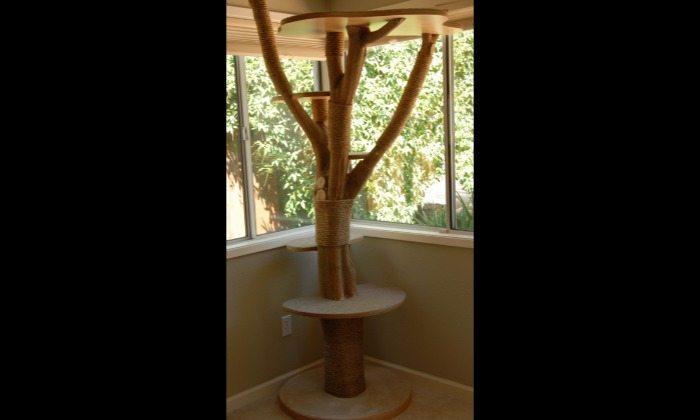
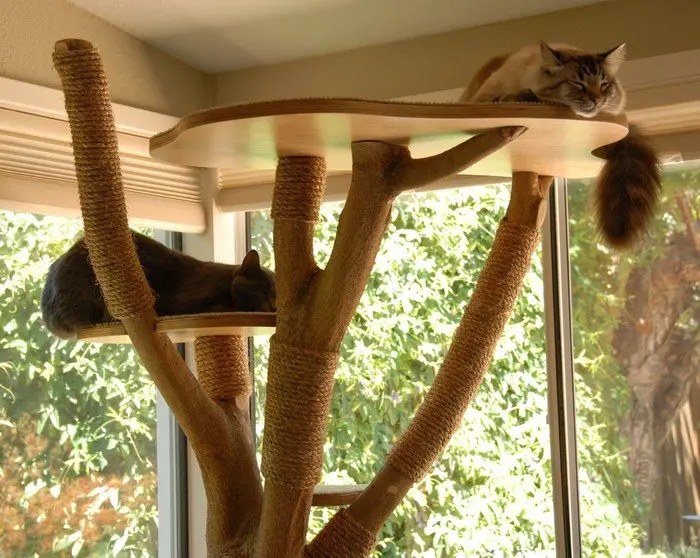
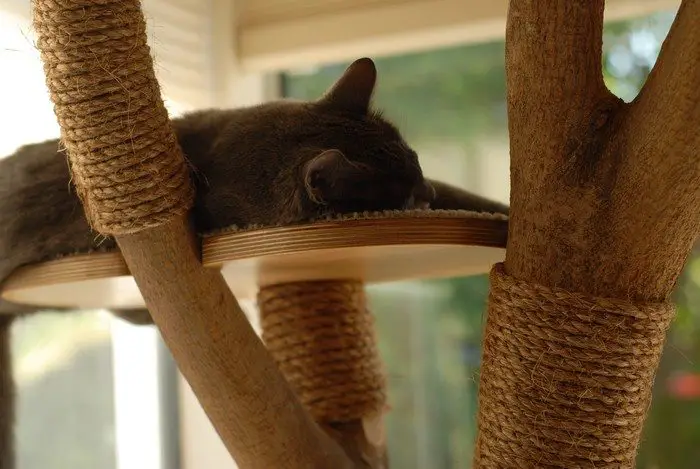

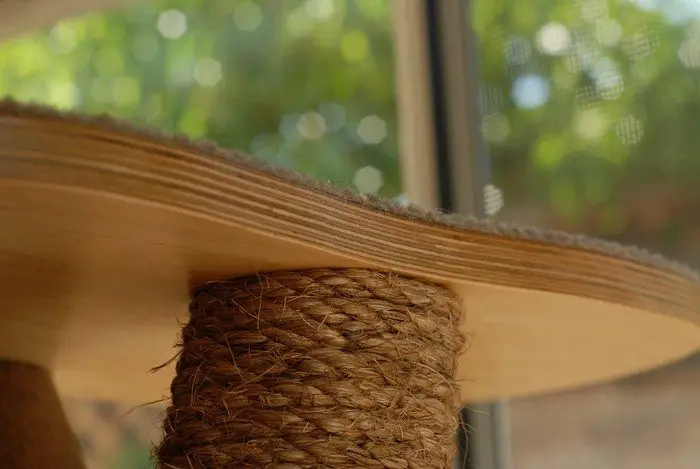

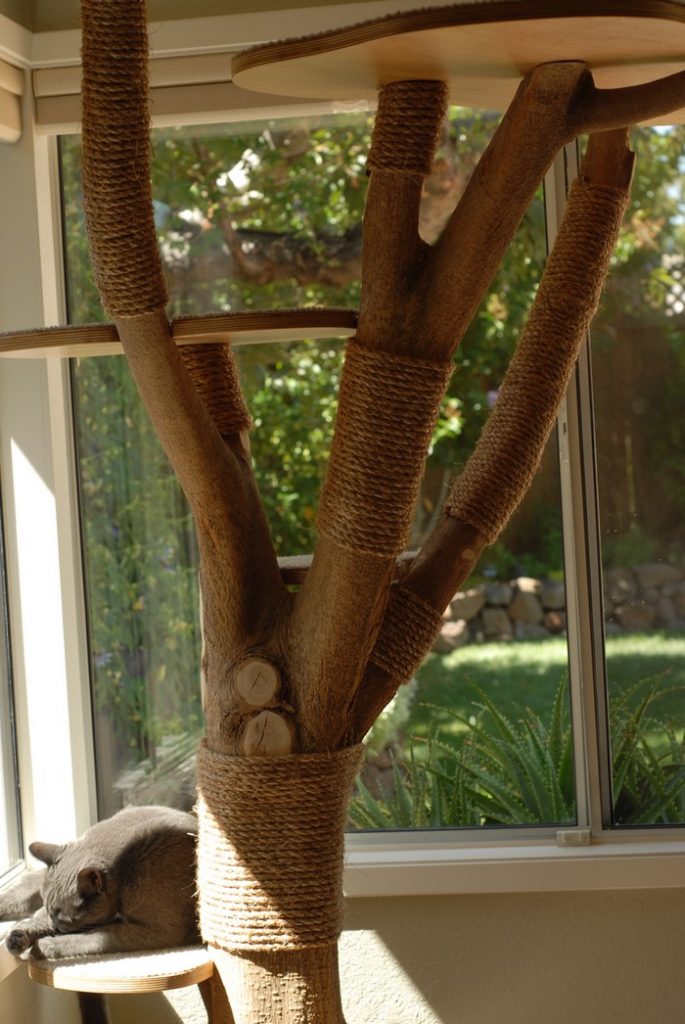

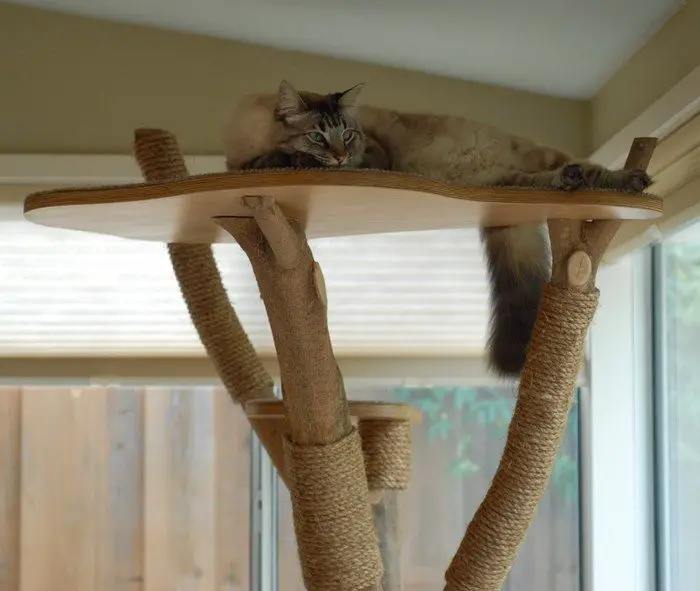
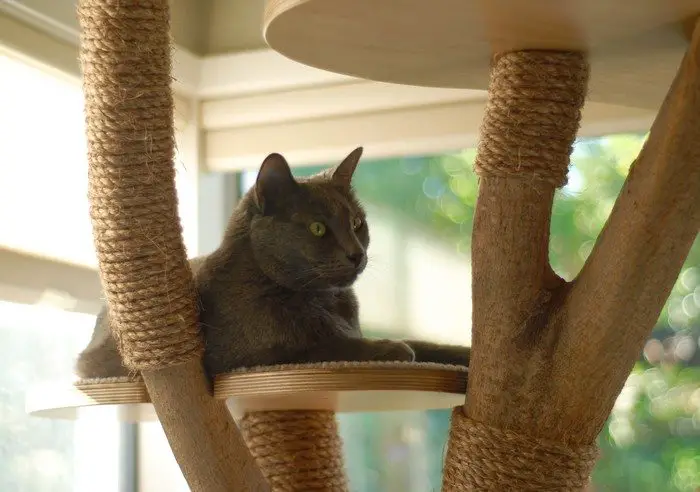
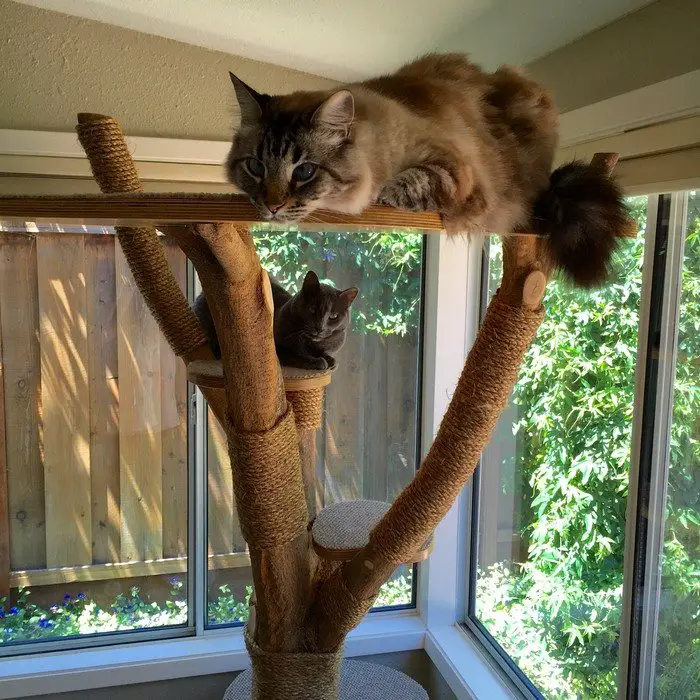
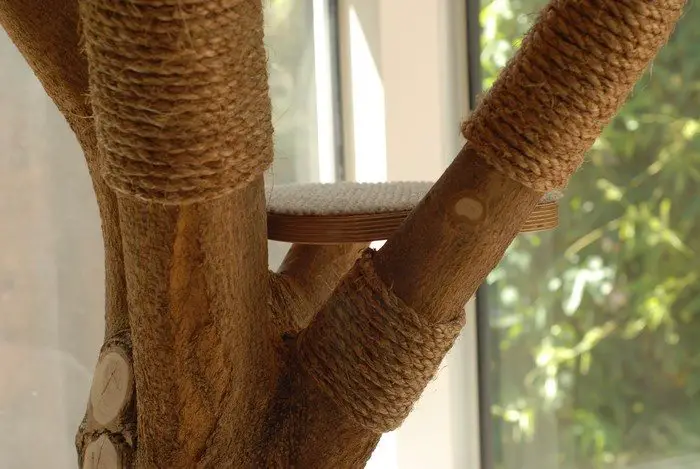
You can get more step-by-step instructions here…
Selecting the Right Tree for Your Cat Tower
Turning an old tree into a cat tower is a creative and eco-friendly way to enhance your pet’s living space. The key to a successful DIY cat tower is starting with the right type of tree. Here’s how to select the best tree for your project:
Consider the Size and Shape
- Height: Choose a tree that is tall enough to provide ample climbing space but fits comfortably within your ceiling height when placed indoors.
- Stability: The trunk should be thick and sturdy to support the weight of the cat without tipping. Look for trees with a solid base.
- Branch Configuration: Opt for a tree with multiple branches at various angles. These natural perches will be ideal for your cat to climb and rest on.
Check the Wood Type
- Non-Toxic Wood: Ensure the tree is non-toxic and safe for cats. Common safe woods include oak, apple, and ash. Avoid toxic varieties like cherry, lilac, and yew.
- Durability: Hardwoods, such as oak or maple, are preferable due to their durability and resistance to scratching.
Inspect for Health
- Disease-Free: Carefully examine the tree for signs of disease or infestation. Healthy wood should not have cracks, splits, or signs of rot.
- Pest-Free: Look for any indications of insect infestation. Holes, sawdust, and weakened wood are red flags.
By selecting the right tree, you ensure the safety and longevity of your cat tower, creating a fun and secure environment for your cat to enjoy.
Behavioral Benefits for Cats
Integrating a cat tower into your home isn’t just about fun; it’s about fostering a healthy, stimulating environment for your feline friend. Here’s how a cat tower can significantly benefit your cat’s behavior:
Promotes Exercise
- Encourages Climbing: Cats have a natural urge to climb, and a cat tower provides the perfect outlet for this behavior. It helps them stay active and agile, reducing the risk of obesity.
- Enhances Coordination: Regular use of a cat tower helps improve a cat’s coordination and balance as they learn to navigate different levels and obstacles.
Supports Natural Instincts
- Safe Refuge: Cats often seek high vantage points for safety and observation. A cat tower offers a secure place where they can watch their surroundings without disturbance.
- Territorial Marking: Cats use scratching to mark their territory. A cat tower with built-in scratching posts allows them to express this natural behavior healthily, saving your furniture in the process.
Reduces Stress
- Personal Space: Having a designated space like a cat tower can significantly reduce stress in cats by giving them a retreat when the household becomes too busy or overwhelming.
- Mental Stimulation: Cat towers often feature various components such as hanging toys and multiple levels which keep cats mentally stimulated and engaged.
Enhances Social Interaction
- Multi-Cat Homes: In homes with more than one cat, a cat tower can provide multiple tiers and spaces for each cat, reducing conflicts and promoting peaceful cohabitation.
- Interaction with Owners: Cat towers can become a focal point for playtime between you and your cat, strengthening your bond.
Enhances Comfort
- Warmth and Comfort: Many cat towers are equipped with cozy platforms or nests lined with soft materials, offering cats a comfortable spot to rest and sleep. This can be especially beneficial for older cats that need a soft surface for their joints.
Facilitates Health Monitoring
- Observation Point: As cats spend a lot of time on their cat tower, it provides pet owners with a consistent location to observe their cat’s behaviors and habits. This can be crucial for early detection of health issues, as changes in behavior can indicate a need for a veterinary visit.
Promotes Confidence
- Boosts Confidence: Shy or timid cats can gain confidence as they explore and conquer the various levels of a cat tower. This increased confidence can translate into less anxiety and more social interaction with humans and other pets.
Encourages Natural Behaviors
- Enriched Environment: A cat tower can mimic the stimulating environment cats would have in the wild, encouraging them to engage in natural behaviors like climbing, leaping, and observing from a height. This enrichment helps keep their minds sharp and their bodies healthy.
Improves Household Dynamics
- Reduces Destructive Behaviors: By providing a designated area for play and exercise, a cat tower can help minimize destructive behaviors in cats. This is particularly beneficial in keeping cats from clawing at household furniture or engaging in other unwanted behaviors.
More than just giving your cat a piece of furniture, a cat tower improves their quality of life in many ways.
Why do indoor cats seek out high perches?
Cats often seek high vantage points for safety and observation. A cat tower offers a secure place where they can watch their surroundings without disturbance.
This behavior is rooted in feline instincts. Cats have an innate drive to find the highest spot to perch, giving them an unobstructed view of their environment. This elevated position not only allows them to survey their territory but also provides a sense of security, knowing they are out of reach from potential threats.
Even for indoor cats, which don’t face the same dangers as outdoor ones, the urge to seek height remains strong. Whether it’s climbing the tallest tree outside or settling for the highest shelf inside, this instinctual behavior persists.
By providing a cat tower, you cater to these natural instincts, offering your feline friend a comfortable and safe place to satisfy their need for elevation and observation.
Conclusion
Turning an old tree into a cat tower is an inventive and sustainable way to enhance your cat’s life while repurposing natural materials. This project not only provides a unique play and rest area for your cat but also adds a charming, rustic element to your home decor. By engaging in this DIY endeavor, you create a personalized space that supports your cat’s health and happiness.
Frequently Asked Questions
- How will my cats likely react to the placement?
- Cats are likely to show interest in the new setup even before it’s fully assembled, especially if it’s in an appealing location.
- What environmental features should I consider when placing the cat tree?
- Look for a spot that receives plenty of natural sunlight, as cats generally enjoy basking in the warmth.
- Where exactly in the house should I place the cat tree?
- Consider setting up the cat tree in a bright area like the living room or a screened-in porch for optimal feline enjoyment.
- Why might a cat choose the tallest available spot, even indoors?
- Despite the lack of outdoor threats, indoor cats continue to pursue the highest available spaces as they fulfil their natural desire for observation and safety.
- Is this behavior necessary for indoor cats?
- While not essential for survival in an indoor setting, cats still seek high places due to their ingrained instincts, signifying the behavior’s deep-rooted nature.
- What are the cosmetic features you can add to a cat tree?
- Your cats would need rope-covered branches for climbing or scratching, as well as a carpet on the platforms to make for a warm and cozy resting place.
- You can also create platforms in tube shape so they can have some crawl space to curl into (you know how cats just love to squeeze themselves into tiny spaces!).
- What is the purpose of these cosmetic elements?
- The branches serve a decorative purpose and are not intended to support any weight.
- How should the cosmetic elements be installed?
- Position the branches beneath the side platforms, ensuring their ends rest flat against both the trunk and platform bases. Secure them using 2” screws.
- How should the cosmetic elements be shaped?
- The ends of the branches should be cut at an angle of about 45 degrees.
- What size should the cosmetic elements be?
- These branches should be approximately two inches in diameter and cut to a length between ten and twelve inches.
- These branches should be approximately two inches in diameter and cut to a length between ten and twelve inches.

